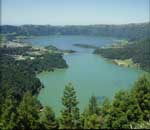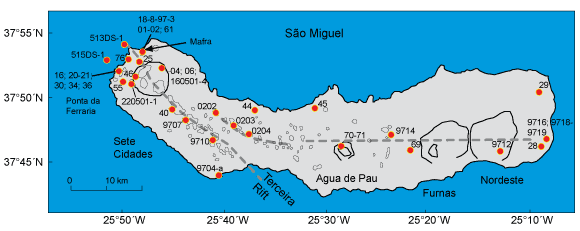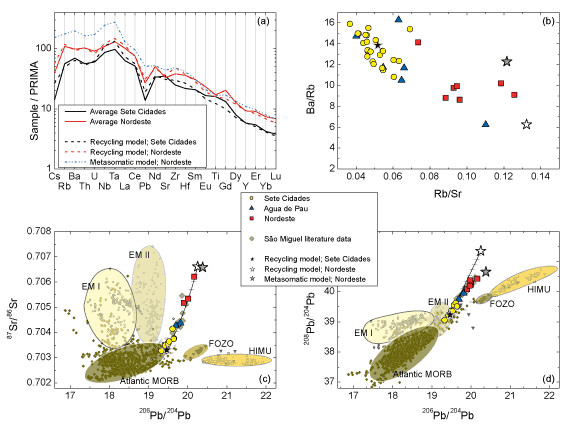 |
The
peculiar geochemical signatures of São
Miguel (Azores) lavas: metasomatised or recycled
mantle sources? |
Christoph
Beier1,2,*,
Andreas
Stracke1,† & Karsten
M. Haase2,3
1Max-Planck-Institut
für
Chemie, Postfach 3060, 55020 Mainz, Germany
2Institut
für Geowissenschaften, Christian-Albrechts-Universität
zu Kiel, Ludewig-Meyn-Straße 10, 24118 Kiel,
Germany
3Department
of Earth Sciences, University of Aarhus, Høegh-Guldbergs
Gade 2, 8000 Aarhus C, Denmark
†present
address: ETH Zürich, Isotopengeologie
und Mineralische Rohstoffe, Clausiusstr. 25, NW D84,
CH-8092 Zürich, Switzerland
*present
address: ARC National Key Centre for
Geochemical Evolution and Metallogeny of Continents
(GEMOC), Department of Earth and Planetary Sciences,
Macquarie University, NSW 2109, Sydney, Australia,
Phone: +61/2/9850-4405, Fax.: +61/2/9850-8943
cbeier@els.mq.edu.au,
stracke@erdw.ethz.ch, karsten.haase@geo.au.dk
 Click here to
download a PDF version of this webpage Click here to
download a PDF version of this webpage
1. Introduction
This webpage summarises our recent
paper published in Earth and Planetary Science Letters
discussing and modelling the source composition of
São
Miguel (Azores) lavas (Beier
et al., 2007). Among
OIB, the lavas erupted on São
Miguel (Figure 1) are in many respects geochemically
unusual. We present new major element,
trace element and Sr, Nd, Pb and Hf isotope data
that cover the entire compositional spectrum. The
mechanism most often invoked to explain the enriched
mantle signatures of OIB is recycling of oceanic
crust (e.g., Weaver et al., 1986; Zindler
& Hart, 1986). However, the geological, physical and chemical
processes involved in creation and recycling of continental and
oceanic crust, and/or melt-rock interaction processes, are
complex and the range of plausible
input parameters for quantitative estimates of the
chemical and isotopic composition is large
(Hart & Zindler, 1989; Kelley
et al., 2005; Stracke
et al.,
2003; Workman et
al.,
2004). Although the
large compositional range and unusual
isotopic composition of the São Miguel lavas
provides relatively tight constraints on source
composition,
they do not allow conclusions regarding where and
when the Azores melting anomaly formed and what the the
physical reasons for this melting anomaly are. This is, to some
extent, the subject of two papers in preparation.

Figure 1: Map of São Miguel
with main tectonic features (grey dotted lines) and
sample locations. Click here or
on Figure for enlargement.
2. Melt
composition and evolution
The São
Miguel samples are mostly alkali basalts with MgO concentrations
up to 14.1 wt. % but range to more evolved rocks (~0.2
wt. %). Samples from each volcanic system lie on a
single liquid line of descent indicating progressive
fractionation. Syenite assimilation has previously
been invoked to influence the major and trace element
composition of the São Miguel lavas (Elliott
et al., 2007;
Storey et al., 1989; Widom
et al., 1993). We found no physical and/or
geochemical evidence for such assimilation at Nordeste.
Similar Na2O, FeO2,
SiO2, TiO2, La/Sm and Sm/Yb ratios
for all São
Miguel lavas suggest a comparable extent and pressure
of partial melting (see also Elliott
et al.,
2007) for the western and eastern lavas.
3.
Inter-island compositional differences and mantle source
characteristics
Comparison of the average trace element
composition of the primitive Nordeste and Sete Cidades
samples shows that the Nordeste lavas are generally
enriched relative to the Sete Cidades lavas. A
gradual increase in the relative enrichment in some
incompatible element concentrations from the west to
east is also observed in previous studies (Elliott
et al., 2007; Turner
et al., 1997; Widom
et al., 1997).
The Nordeste lavas are more enriched in
Cs, Rb, Th, U and Pb but more depleted in Sr, Ba, Ti
and, to a lesser degree, in Eu relative to the Sete
Cidades lavas. Compared to other OIB, the average trace
element concentrations of both the Nordeste and especially the Sete
Cidades are similar to those in HIMU basalts (e.g., St.
Helena, Tubuaii) but have slightly higher alkali (Cs,
Rb, K, Ba) and Th concentrations.
The Sr, Nd, Pb and Hf isotope ratios
of the São Miguel samples (Figure 2) display
a large range of linearly correlated isotope ratios
with progressively higher Sr and Pb, and lower Nd and
Hf isotope ratios from west (Sete Cidades) to east
(Nordeste; e.g. Elliott
et al., 2007; Turner
et al., 1997; Widom et al., 1997). The
Sete Cidades lavas are similar to some enriched MORB
and lavas from other Atlantic ocean islands, whereas
lavas from Nordeste have unusual isotopic compositions
with highly radiogenic Pb and Sr isotope ratios and
low Nd and Hf isotope ratios, unlike any of the previously
defined mantle end-members (Zindler
& Hart, 1986).
Despite the similarity of the trace element concentrations
and Pb isotope ratios to those found in typical HIMU
lavas, for example, the Sr isotope ratios of the Nordeste samples
are clearly unlike those in typical HIMU islands, which
are characterised by low and relatively constant Sr
isotope ratios (Figure 2).

Figure 2: 206Pb/204Pb
versus Sr, εHf, Nd and 208Pb/204Pb
isotope data of the São Miguel
volcanoes Sete Cidades, Agua de Pau and Nordeste. The
overlapping isotopic trends of Agua de Pau and Sete
Cidades mainly reflect samples from from a a zone of scoria
cones between the two volcanoes, with two overlapping
rift zones, each connected to one of the two systems
(Haase & Beier, 2003). The HIMU, MORB, FOZO and
EM (Enriched Mantle) compositions are referenced in detail in Stracke
et al. (2003; 2005). Click here or
on Figure for enlargement.
Generally, most of the trace
element ratios (LILE and HFSE) that differ
between the two volcanic centres correlate with
differences in isotopic compositions (Beier
et al., 2007). Lack
of evidence for syenite accumulation and concurrent
enrichment of the trace element and isotope ratios
observed in this study, however, suggest that trace
elements and isotopes are enriched by the same process
and imply a close genetic relationship between
the two mantle sources.
4. Discussion
4.1 The São Miguel
mantle source
Our data support the conclusion of
Elliott et al. (2007) that previously proposed
models involving enrichment by sediments or subcontinental
lithospheric mantle are unlikely to explain the enrichment
of the Nordeste mantle source.
The coupled high Sr
and Pb, and low Nd and Hf isotope ratios require a
source with a long-term evolution with high Rb/Sr,
U/Pb, Th/Pb, Th/U and low Sm/Nd and Lu/Hf parent daughter
ratios. The coupled enrichment of Rb/Sr, U/Pb and Th/Pb
argues against the presence of sediments, because even
minute amounts of sediment significantly increase the
Pb concentrations and Th/Pb and U/Pb ratios, which
leads, with time, to relatively unradiogenic Pb isotope
ratios. As a result of previous melt extraction events,
refractory lithospheric mantle is generally characterised
by high 176Hf/177Hf and low 187Re/188Os
isotope ratios (Bizimis
et al.,
2003; Jung
et al.,
2005; Salters
et al.,
2006) leading to very
radiogenic Hf and Os isotope ratios (Ionov
et al.,
2005; Salters & Zindler, 1995; Schmidberger
et al., 2002). This is contrary to the ratios
observed at Nordeste. While published 187Re/188Os
isotope data (Schaefer
et al., 2002; Widom & Shirey,
1996) from several Azorean islands including São
Miguel do have relatively low 187Os/188Os
isotope ratios, they also have very low 176Hf/177Hf
isotope ratios. Recycled subcontinental lithosphere therefore
seems unlikely to account for the enriched Nordeste signature.
4.1.1
Metasomatic interaction
Infiltration or metasomatism
of the sub-oceanic mantle by small-degree
metasomatic melts leads to enrichment in incompatible elements
proportional to the enrichment and relative proportion
of the melts involved. The calculated composition
of a small degree (0.5-1% degree of partial melting)
melt generated from a depleted upper mantle source
(Salters & Stracke, 2004) in the
garnet stability field shows a melt composition that
is even more enriched than most OIB. Infiltration and
mixing of small amounts (1-2%) of these melts with
depleted upper mantle generates enriched peridotite
sources which can develop isotopic compositions comparable
to those of Nordeste, provided there is enough
time (~2.5 Ga) for the evolution of isotopic signatures
(Figure 3).
Compared to Nordeste, the Sete Cidades
isotope ratios require the infiltration of a smaller
amount (1%) of slightly higher degree melts (3-5% degree
of partial melting) to be consistent with the observed
isotopic compositions. Although the metasomatic interaction
scenario reproduces the isotopic composition of both
the Nordeste and Sete Cidades lavas, the small-degree
partial melts imprint their highly enriched trace element
signature on the metasomatised mantle, often generating
sources that have even more enriched trace element
signatures than most OIB (see
also Workman
et al.,
2004). For the specific case of São Miguel, the Nordeste
lavas have lower Nb/Zr than the Sete Cidades basalts. If Nordeste’s
lavas are produced by metasomatic melts generated with smaller degrees
of partial melting than those metasomatising the Sete Cidades source,
as required by the isotopes, then Nordeste would be expected to
have higher Nb/Zr ratios.

Figure 3: Calculated trace element
and isotopic composition of the recycling (Sete Cidades,
Nordeste) and melt metasomatism models. Tick marks
of the mixing array represent 10% steps of the mixing
array between the calculated Sete Cidades and Nordeste
recycling models. Trace element and isotope ratios
of the metasomatic model (grey star) also proposed
by Elliott
et al. (2007) and the proposed recycling
model (white star) of ancient, altered recycled oceanic
crust with evolved seamount lavas, are in agreement
with the Nordeste trace element and isotope signatures.
For detailed model parameters see Beier
et al. (2007).
HIMU, MORB, FOZO and EM compositions are
referenced in detail in Stracke et al. (2003; 2005).
The HIMU data (St. Helena) were compiled from the GEOROC
database and Willbold
& Stracke (2005). Click here or on Figure for enlargement.
4.1.2
Recycling
The correlation between Sr and Pb
isotope ratios requires long-term evolution with
coupled high parent-daughter ratios. Basaltic crust
that is significantly affected by sub-arc alteration
develops, with time, relatively low Sr and high Pb
isotope ratios similar to those observed in HIMU basalts
(Stracke et al.,
2005; Willbold
& Stracke,
2005; Zindler & Hart, 1986). As a consequence, recycled
basaltic crust is only compatible with the isotopic
signatures of the São Miguel lavas
when it has not been influenced by extensive sub-arc alteration.
The average isotopic composition
of Sete Cidades overlaps with the compositional range
defined by the depleted ends of many OIB arrays (FOZO; Hart
et al., 1992; Stracke
et al.,
2005). Recycled
oceanic crust must be relatively enriched with high
Rb/Sr, U/Pb and Th/Pb in order to be compatible
with the moderately enriched Sr and Pb isotope ratios
of the FOZO/Sete Cidades lavas. Since Pb is probably
the most mobile element during sub-arc alteration (Kogiso
et al., 1997), Pb concentrations are most easily
affected during sub-arc alteration resulting in elevated
Ce/Pb, U/Pb and Th/Pb . It seems conceptually
plausible, therefore, that the Sete Cidades (FOZO)
mantle source includes ancient recycled oceanic crust
that has experienced some Pb loss during sub-arc alteration
(Stracke et al.,
2005), but that other elements remained
relatively little affected by sub-arc alteration processes.
The Nordeste lavas have lower Ce/Pb,
U/Pb and Ba/Rb and higher Rb/Sr, Th/U and Sr isotope
ratios compared to both Sete Cidades and HIMU lavas.
Thus, if both the Sete Cidades and Nordeste sources
are explained by recycled oceanic crust, the larger extent
of sub-arc alteration inferred for Sete Cidades is
incompatible with the trace element and isotopic differences
between the two volcanoes. The Nordeste lavas are generally
more enriched in incompatible elements but depleted
in Sr (relative to Nd), Eu, Ti (relative to Gd) and
Ba relative to Rb compared to Sete Cidades lavas. These
depletions could be explained if the precursor rock
of the Nordeste source originated from a melt that
had previously undergone extensive fractionation of
K-feldspar and Fe-Ti oxides. A ubiquitous source of
evolved and chemically and isotopically enriched lavas
on the ocean floor are seamounts (McKenzie
et al.,
2004). Adding a small amount of trachyte to the modelled
composition of the Sete Cidades mantle source quantitatively
reproduces the Nordeste trace element pattern and isotopic
composition.
The recycling of both slightly altered
basaltic and evolved melts therefore significantly
increases the Rb/Sr, U/Pb, Th/Pb and Th/U ratios, and
is able to explain both the trace element and isotope
systematics of the Nordeste lavas. It can also account
for the correlation between trace element concentrations
and isotope ratios between the Sete Cidades and Nordeste
lavas.
5. Conclusions
The long-term evolution
of trace element and isotopic enrichment of the
Nordeste lavas suggested by the coherent correlation
of isotope and trace element ratios requires
involvement of a basaltic melt, either by melt metasomatism
or recycling of oceanic crust. Although the metasomatic
scenario is compatible with the isotope ratios (Elliott
et al.,
2007), it fails to reproduce successfully the
trace element signatures, a conclusion that is to a
large extent independent of the exact input parameters
(e.g. initial starting composition, partition coefficients).
The trace element and isotopic composition
of São
Miguel suggest that subduction and recycling of
enriched evolved rocks may in some cases be detectable
via the trace element and isotopic composition of OIB
and may contribute to the evolution of mantle heterogeneities.
The sparse occurrence of enriched source signatures
comparable to Nordeste may be taken as circumstantial
evidence that, at least in some cases, stirring
and homogenisation processes in Earth’s mantle
cannot homogenise material the size of
seamounts over relevant timescales.
Acknowledgments
We acknowledge the
invitation of Gillian Foulger to present a summary
of our paper in this webpage.
References
-
-
-
-
-
Hart
S. R., Hauri E. H., Oschmann L. A., and Whitehead
J. A. (1992) Mantle plumes and entrainment; isotopic
evidence. Science 256(5056),
517-520.
-
Hart S. R. and Zindler A. (1989) Constraints
on the nature and development of chemical heterogeneities
in the mantle. In Mantle convection; plate tectonics
and global dynamics, Vol. 4, pp. 261-387.
Gordon & Breach
Science Publishers.
-
Ionov D. A., Ashchepkov I., and
Jagoutz E. (2005) The provenance of fertile off-craton
lithospheric mantle; Sr-Nd isotope and chemical composition
of garnet and spinel peridotite xenoliths from Vitim,
Siberia. Chemical
Geology 217(1-2), 41-75.
-
-
-
Kogiso T., Tatsumi Y., and Nakano
S. (1997) Trace element transport during dehydration
processes in the subducted oceanic crust; 1. Experiments
and implications for the origin of ocean island basalts. Earth
and Planetary Science Letters 148(1-2),
193-205.
-
McKenzie D., Stracke A., Blichert
T. J., Albarede F., Gronvold K., and O N. R. K. (2004)
Source enrichment processes responsible for isotopic
anomalies in oceanic island basalts. Geochimica
et Cosmochimica Acta 68(12),
2699-2724.
-
-
Salters V. J. M. and Stracke A. (2004)
Composition of the depleted mantle. Geochemistry,
Geophysics, Geosystems 5(5),
doi: 10.1029/2003GC000597.
-
Salters V. J. M. and Zindler
A. (1995) Extreme 176Hf/177Hf in the sub-oceanic
mantle. Earth
and Planetary Science Letters 129(1-4),
13-30.
-
Schaefer B. F., Turner S., Parkinson
I., Rogers N., and Hawkesworth C. (2002) Evidence
for recylced Archaean oceanic mantle lithosphere
in the Azores plume. Nature 420,
304-307.
-
Schmidberger S. S., Simonetti A.,
Francis D., and Gariepy C. (2002) Probing Archean
lithosphere using the Lu-Hf isotope systematics of
peridotite xenoliths from Somerset Island kimberlites,
Canada. Earth
and Planetary Science Letters 197(3-4),
245-259.
-
Storey M., Wolff J. A., Norry M. J.,
and Marriner G. F. (1989) Origin of hybrid lavas
from Agua de Pau volcano, Sao Miguel, Azores. In Magmatism
in the Ocean Basins,
Vol. 42 (ed. A. D. Saunders and M. J. Norry), pp.
161-180. Geological Society Special Publication
of London.
-
-
-
Turner
S., Hawkesworth C., Rogers N., and King P. (1997)
U-Th isotope disequilibria and ocean island basalt
generation in the Azores. Chemical Geology 139(1-4),
145-164.
-
Weaver B. L., Wood D. A., Tarney J.,
and Joron J. L. (1986) Role of subducted sediment
in the genesis of ocean-island basalts; geochemical
evidence from South Atlantic Ocean Islands. Geology 14(4),
275-278.
-
Widom E., Carlson R. W., Gill J. B.,
and Schmincke H. U. (1997) Th-Sr-Nd-Pb isotope and
trace element evidence for the origin of the Sao
Miguel, Azores, enriched mantle source. Chemical Geology 140(1-2),
49-68.
-
Widom E., Gill J. B., and Schmincke
H. U. (1993) Syenite nodules as a long-term record
of magmatic activity in Agua de Pau Volcano, Sao
Miguel, Azores. Journal
of Petrology 34(5), 929-953.
-
Widom
E. and Shirey S. B. (1996) Os isotope systematics
in the Azores: implications for mantle plume sources. Earth
and Planetary Science Letters 142,
451-465.
-
-
Workman
R. K., Hart S. R., Jackson M., Regelous M., K.A.
F., Blusztajn J., Kurz M. D., and Staudigel H. (2004)
Recycled metasomatized lithosphere as the origin
of the Enriched Mantle II (EM2) end-member: Evidence
from the Samoan Volcanic Chain. Geochemistry, Geophysics,
Geosystems 5(4), doi:10.1029/2003GC000623.
-
Zindler
A. and Hart S. (1986) Chemical Geodynamics. Annual
Review of Earth and Planetary Sciences 14,
493-571.
last updated 6th
August, 2007 |
